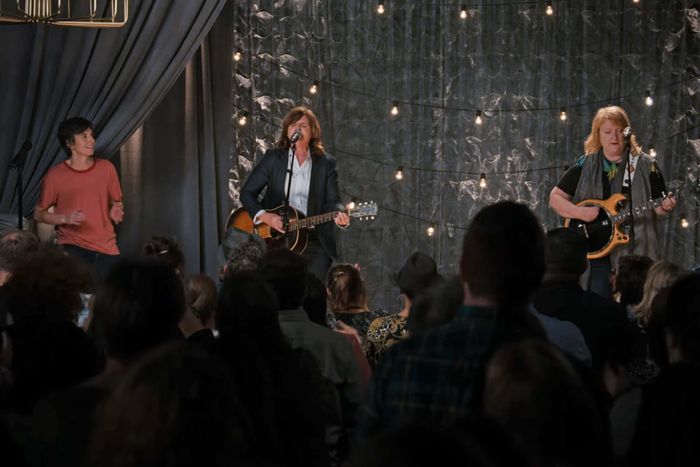
Conventional stand-up wisdom states that comedy sets should end on their biggest laugh, which is why most specials and albums end on a broad, crowd-pleasing joke or a callback that offers a satisfying payoff. Of course, there are exceptions. In his 15-minute special featured on Netflix’s The Comedy Lineup in 2018, comedian Ian Karmel intentionally ended on a note he called “weird and incomplete.” In his 2019 HBO special, Feelings, Ramy Youssef’s final joke was more or less an excuse to ask the thought-provoking question, “Did 9/11 work?” And in nearly all of her albums and specials released to date, Tig Notaro has pushed the boundaries of what audiences understand a typical closer to look like by doing something distinct or unconventional. With her new Amazon Prime special, Hello Again, released March 26, Notaro once again adds to her résumé of closer innovations, so we figured we’d take the opportunity to revisit the comedian’s previous experiments with this device.
Good One (2011)
Where Notaro’s 2004 Comedy Central Presents special appears to have predated her interest in unorthodox closers, this fascination is on full display on her debut stand-up album, Good One, recorded on Notaro’s 40th birthday. The album’s final track, “The Show’s Over,” begins with the comedian unceremoniously making this pronouncement. Unsettled by the absence of a big closing joke, the audience lets out an uncertain laugh, so Notaro doubles down on the subversion: “I feel like this is one of those situations where you’re a clown and you’re trying to, like, cry for help, and nobody will have it … But my show is over.” More hesitant laughs and applause follows. “No clapping!” Notaro chastises. “You missed your chance!” For a second, the show seems poised to end on this meta-note, but then an audience member shouts out “Happy birthday!” and the crowd erupts in a spontaneous rendition of the “Happy Birthday” song, creating the grand ending they were grasping for initially.
Live (2012)
At various points throughout Notaro’s breakout 2012 album, Live — in which she discusses being diagnosed with stage two breast cancer just four days before this recording, the recent death of her mother, and a fresh breakup — Notaro makes vague reference to a previously written joke about a bee she says now feels dated and superfluous to perform given her recent news. Eventually, plumb out of tragedy to unpack and searching for a way to end the unpolished set, Notaro turns to the audience and asks for suggestions for a topic they’d like “like to hear a silly joke about.” “Tell the bee joke!” an audience member requests. Notaro obliges, launching into a bit about the frustrating feeling of being stuck in L.A. freeway traffic so slow that she was able to notice a bee zoom by (“P.S.: What was the bee doing taking the 405 in the first place?”). The joke gets huge laughs less on the merits of its structure than its violent incongruence with the tone of the rest of Notaro’s material, validating her instincts about it in the first place.
Boyish Girl Interrupted (2015)
A lot of closers benefit from the use of a callback, but in her HBO special Boyish Girl Interrupted, Notaro makes use of a much rarer device: the call forward. About nine minutes before the end of the special, Notaro does a silly bit about how every show she’s ever done, including her disastrous bombs, has ended in a standing ovation. “You might be thinking, I had a good time tonight. But not standing-ovation-good time,” she says. “Everybody thinks that. Then, sure enough, the show ends and everyone jumps to their feet.” Notaro’s final joke in the special, then — a relatively standard Notaro story about a childhood embarrassment involving the Rolling Stones song “You Can’t Always Get What You Want” and its very long choral intro — is not its closer. The closer is the standing ovation she gets irrespective of it afterwards and the way she reacts to it by saying, “What?! I told you! Please, be seated. I’m just a person!”
Happy to Be Here (2018)
Two years before Notaro recorded this special for Netflix, Vulture writer Jesse David Fox saw her perform its closer at Carnegie Hall and referred to it as the “best closer I’ve ever seen.” This may still be true. “I would love to offer up a surprise for everybody, if you would like to have a surprise,” Notaro kicks off the bit. Then she spends the next ten minutes continuously introducing a performance by the band the Indigo Girls, only for the band to no-show onstage. At first, the audience believes Notaro’s assurances that the Indigo Girls are waiting backstage to perform. Then they lose faith. Then Notaro continues talking about it for long enough that the audience starts to feel like the bit couldn’t possibly end in anticlimax. Then Notaro makes those people feel dumb for believing her again. “You’re on a bit of a roller-coaster ride,” Notaro correctly surmises at one point. By the time the Indigo Girls do eventually show up, it’s almost beside the point.
Drawn (2021)
As an animated special cut together from discrete bits and stories Notaro performed at Los Angeles’s Largo in the years preceding this release, the closer of HBO’s Drawn — a bit about going on a road trip and listening to the Dolly Parton song “Two Doors Down” on repeat — benefits greatly from the special’s medium. For one thing, it is the most dramatic visual in the special — a nightmarish scene of a car losing control and flipping down a hill — that’s fitting for a climactic finale. Then there are the visual callbacks littered throughout the animation — not just to earlier parts of the special, but to earlier jokes from Notaro’s career. (At one point, we see her flipping through a binder of burned CDs with entries labeled “Indigo Girls” and “Taylor Dayne.”) Then there is the song itself, which plays on repeat throughout the bit and creates the feeling of a big ending, not unlike the crowd singing “Happy Birthday” on Good One. It would seem Notaro picked up a lesson from that experience, since five of the six closers on this list feature music.
Hello Again (2024)
“You probably don’t know this about me, but I do love to sing and play the piano,” Notaro says toward the end of Hello Again. On cue, a regal grand piano is rolled onto the stage. Then Notaro adds a crucial caveat — “I don’t know how to do either” — before she starts to haphazardly plink the keys without regard for technique, musical theory, or even pleasant ambiance.
After several minutes of this, Notaro tells a story about a celebrity-packed party she attended, at which all eyes were on Adele while famous musicians took turns getting onstage and entertaining the other guests by playing short sets. Upon realizing Adele wasn’t going to cave to the pressure to join the performance fray, Notaro took matters into her own hands. She got onstage and played a rendition of Adele’s “Hello” for the eager guests — again, with no musical ability and in front of the artist herself. “That is what I was thinking I just might play for you tonight,” Notaro says. But in typical fashion, she doesn’t jump right into it: “I just need to warm up a little more.”
She drags out the reveal, building anticipation by telling another story, jokingly apologizing to any people in the audience unaware of her comedic sensibility, and taking unrelated song requests from the audience (“Why does it even matter? I don’t know how to play piano”). This goes on for long enough that she feels compelled to offer a disclaimer: “I know people are like, I know what’s coming: I bet she’s a great piano player, and I bet she sings like a bird. That is not on the horizon.” It only adds to the suspicion that a twist might be coming. Notaro loves faking audiences out, after all. Finally, after all that, she begins to play the song. The squawking sound she makes cannot be done justice in text. It wasn’t a fake-out after all. Or maybe it was a double fake-out? With Notaro, you can never be sure.



